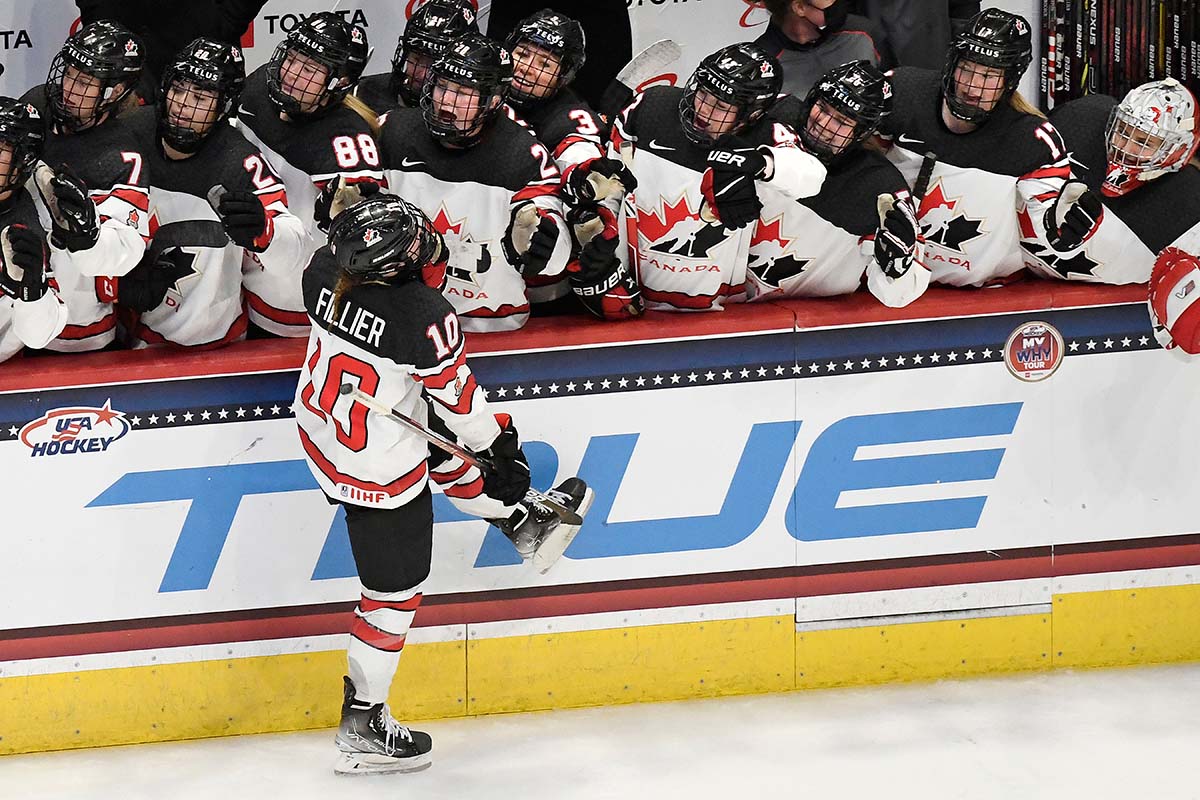Written by , Ryerson University. Photo credit: AP Photo/Jessica Hill. Originally published in The Conversation.![]()
Canada’s Sarah Fillier celebrates her goal during overtime play of a women’s hockey game against the United States in a pre-Olympic Games series in October 2021.
The multi-year, multi-platform broadcast deal recently inked between the CBC and the Canadian Hockey League might be good news for fans of men’s junior hockey, but for women’s professional hockey, it is at best a missed opportunity and at worst a slap in the face.
As media executives invest scarce production dollars into even more men’s hockey, audiences for women’s hockey have often been left watching either exhibition tournaments live or poorly produced, hard-to-find games online.
The chicken and egg argument around the low-to-no media coverage for women’s sports goes like this: broadcasters claim they can’t make the investment in high-quality production for women’s sport without a guaranteed audience to sell to advertisers while athletes, activists and academics argue that audiences cannot be built without broadcaster investment.
If there is no media coverage for women’s hockey, does that mean there is no audience?
What came first? Investment or audience?
As a sports scholar and TV/media producer, I bring a unique perspective to this argument. In my academic research I found an enthusiastic, engaged audience for Olympic women’s hockey that says they don’t watch the professional women’s games because they don’t know when or where to find them.
Is this the fault of the viewers fault or the broadcasters for failing to muster, mobilize and monetize this audience-in-waiting? As communication and culture researcher Ryan Phillips argues, the audiences for men’s hockey didn’t just simply appear. Instead, CBC spent 50 years investing in its construction, building and eventually expanding the audience to include women. This happened not just through the broadcast of individual games, but through a commitment to develop the brand using every opportunity and platform available.
Scott Stinson, a sports columnist for the National Post, described something similar with men’s junior hockey, crediting the crew’s passion for and belief in the game for its success as a ratings-winning television event.

It takes more than a token broadcast
Women’s professional hockey hasn’t received anything close to this level of broadcaster investment or commitment.
The now-defunct Canadian Women’s Hockey League (CWHL) received sparse game coverage from Sportsnet and arguably lacklustre promotion. The Professional Women’s Hockey Players Association (PWHPA) formed in the wake of the CWHL demise has only the occasional game broadcast on NBCSN, CBC Sports, CBC Gem and Sportsnet.
The U.S.-based Premier Hockey Federation (PHF), formerly the National Women’s Hockey League, saw two of its 2021 tournament games broadcast on NBCSN, but otherwise relied on its streaming deal with Twitch.
While some reports indicate views measuring in the tens of thousands and even over a million, the league’s two Twitch channels have more than 30,000 and more than 6,000 followers on each, with views for most games in the hundreds.
The 2021-22 season looks better for the PHF. As it enters into an exclusive partnership with ESPN+, the platform promises to broadcast 60 regular-season games, including the Isobel Cup playoffs, and other special events.
Premier Hockey Federation (@PHF) to stream exclusively on @ESPNPlus
∙ The top women's professional hockey league in North America
∙ New rights agreement includes 60 '21-'22 regular season games, special events & the Isobel Cup PlayoffsMore: https://t.co/zC6a2FtsCO pic.twitter.com/BsRsMJMjV5
— ESPN PR (@ESPNPR) October 20, 2021
Women’s professional hockey on Canadian TV
All sport media is struggling as platforms move from conventional broadcast to online streaming. But the issue discussed is often about transitioning audiences rather than building them.
There are benefits to conventional broadcasting, particularly in a corporate infrastructure that has multiple media strands for cross-promotion. Sport, with its “live” nature fits well with television scheduling and, crucially, the costs of production to output a polished show happen up front. Broadcasters mitigate the risk of that investment through airtime and audience eyeballs sold in advance to advertisers, hence the chicken-and-egg problem.
But, television production is always a risk. There is never a guaranteed audience.
Unlike many other industries that buy and sell products, television and media content before production is a concept, well thought out, tested and scrutinized, but still a concept. Broadcasters try to mitigate the risk by licensing international formats (like The Amazing Race, The Bachelor or Big Brother) that promise a tried-and-tested audience, albeit one from another market.
For original content, one way to mitigate risk is to develop programming featuring celebrities, social media influencers or personalities with fame, notoriety and followers who can help build audiences.

If I was pitching professional women’s hockey to a broadcaster, I would highlight Olympic ratings with audiences in the millions, the more than 100,000 person audiences for professional games on NBCSN and multiple star athletes with thousands of social media followers that more than mitigate the risk.
The audience for women’s professional hockey is waiting to be recognized and realized by the same energy and commitment broadcasters devote to men’s hockey. PHF’s deal with ESPN+ could do this. But given that the CBC spent half a century dedicating its public broadcasting dollars to developing the audience for men’s hockey, rather than investing more in men’s hockey, shouldn’t they do the same for the women?

